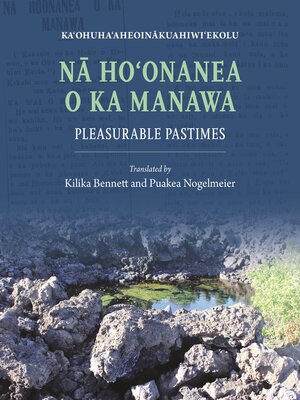
Sign up to save your library
With an OverDrive account, you can save your favorite libraries for at-a-glance information about availability. Find out more about OverDrive accounts.
Find this title in Libby, the library reading app by OverDrive.



Search for a digital library with this title
Title found at these libraries:
| Loading... |
"He mea hoomanao no na hana oia au i hala, a he mea hoi e poina ole ai i na mamo o keia la a mau aku." A memorial for the events of the past, and something to ensure that the children of today and forever more will never forget.
—Kaʻohuhaʻaheoinākuahiwiʻekolu, Ka Hoku o Hawaii
Nā Hoʻonanea o ka Manawa, translated as Pleasurable Pastimes, is a delightful collection of tales and descriptions of life in the northern region of Kona on the island of Hawaiʻi. These moʻolelo (stories) from the arid land known as Kekaha Wai ʻOle O Nā Kona contain the name, location, and nature of hundreds of wahi pana (storied sites) and extensive listings of moon phases, calendrics, counting methods, and plant names—all of which make this assembly a treasury of local knowledge and cultural traditions that extend far beyond the region.
Beginning on September 13, 1923, a series of articles titled Na Hoonanea o ka Manawa appeared weekly in Ka Hoku o Hawaii, a Hilo-based Hawaiian-language newspaper of Hawaiʻi's territorial period, until its closure on August 28, 1924.The author of the series, J. W. H. Isaac Kihe, writing under the name Ka ʻOhu Haʻaheo I Nā Kuahiwi ʻEkolu, was a knowledgeable and prolific contributor to Ka Hoku o Hawaii. Proud of his heritage and concerned about the possible erasure of the cultural knowledge and practices of his homeland, Kihe believed that by documenting and disseminating this information through the press, he could help circumvent its loss and provide an invaluable resource for the people of his time and for generations to come.
One hundred years later, this book presents the complete collection of scanned articles alongside thoughtful English translations by Kilika Bennett and Puakea Nogelmeier, as well as indexes of the named places, people, winds, rains, plants, and animals. In a time when many are looking to remember, relearn, revive, and reintegrate Native Hawaiian knowledge, traditions, and resource management practices, this republication of Kihe's work is a much-needed contribution.






